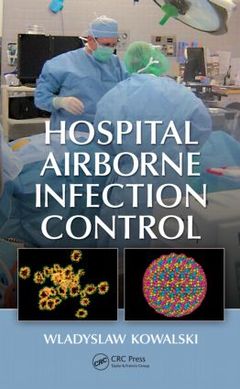Hospital Airborne Infection Control
Auteur : Kowalski Wladyslaw

Although nosocomial, or hospital-acquired, infections have been well cataloged and are fairly well understood, traditional solutions have failed to completely eliminate the problem. Even the most modern hospitals find themselves stymied by the persistence of these pathogens in hospital wards and operating rooms. The degree to which most of these infections are airborne is not known, but a growing body of evidence indicates that airborne transmission plays a role in many hospital-acquired infections.
Addressing one of the most important topics in health care, Hospital Airborne Infection Control is the first book to deal with the control of airborne nosocomial infections in detail. It identifies all pathogens known or suspected to be airborne, along with their sources in hospital environments. It also summarizes all epidemiological evidence for airborne transmission. The text addresses respiratory, surgical site, burn wound, immunocompromised, pediatric, nursing home, and non-respiratory infections. In each category, an extensive number of examples show that inhalation is not the only airborne route by which infections may be transmitted.
Noting that airborne transmission and surface contamination are virtually inseparable, the author emphasizes that both air and surface disinfection, including hand hygiene, are important factors in controlling the transmission of airborne disease. He also proposes a variety of new solutions and technologies, including ultraviolet, ionization, ozone, plasma, and vegetative air cleaning systems. A compendium of scientific and medical information, this book helps hospitals control nosocomial infections and outbreaks spread by the airborne route as well as by direct contact and contact with fomites or contaminated equipment.
Airborne Nosocomial Infections. Airborne Nosocomial Epidemiology. Hospital Aerobiology. Airborne Nosocomial Microorganisms. Airborne Nosocomial Etiology. Hospital Facilities. Ventilation and Dilution. Air Filtration. Hospital Disinfection. Hand Hygiene. Respiratory Infections. Surgical Site Infections. ICUs and Patient Rooms. Pediatric Nosocomial Infections. Immunocompromised and Burn Wound Infections. Nursing Homes. Procedural Controls and Guidelines. Air and Surface Sampling. UVGI Air Disinfection. UVGI Surface Disinfection. Alternative Air Cleaning Technologies. Appendix: Database of Airborne Nosocomial Pathogens. Index.
Wladyslaw Kowalski, PhD, PE, has authored numerous articles related to air cleaning technology, biodefense, and hospital air disinfection, and has authored books and contributed chapters on these subjects, including the ASHRAE HVAC Design Manual for Hospitals and Clinics.He consults with hospitals on indoor air quality issues, including mold and bacterial contamination problems, and investigates hospital infection problems using air and surface sampling. Dr. Kowalski designs air disinfection systems for hospitals and commercial buildings and speaks at international conferences on disease control and air cleaning topics. He is also secretary of the Air Treatment Group of the International Ultraviolet Association (IUVA). He is currently engaged in research on ultraviolet germicidal irradiation (UVGI) and is developing new types of UVGI air and surface disinfection systems for the health care industry.
Date de parution : 12-2011
15.6x23.4 cm
Date de parution : 05-2017
15.6x23.4 cm
Thèmes de Hospital Airborne Infection Control :
Mots-clés :
Airborne Nosocomial Pathogens; Airborne Transmission; nosocomial; Surgical Site Infection; pathogens; UVGI System; transmission; UV System; fungal; AII Room; spores; Clostridium Difcile; surgical; Droplet Nuclei; site; Airborne Transport; infections; SARS Virus; disinfection; Airborne Concentrations; concentrations; UV Dose; Air Disinfection; Exposure Time; Nosocomial Infections; Airborne Microbial; Airborne Infections; Fungal Spores; Aspergillus Spores; Surface Disinfection; Airborne Pathogens; Cooling Coils; VZV; UVC; Burn Wound Infections



